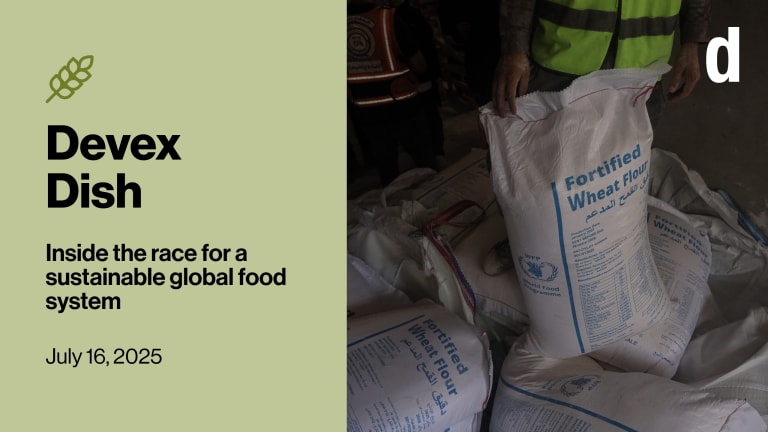
This week, my colleague William Worley has the exclusive on how — according to a former senior United Nations official — Russia and China helped Ethiopia “delay” meetings of the U.N. Security Council to discuss the declaration of famine in the country’s war-torn Tigray region.
Will sat down with Mark Lowcock, the former undersecretary-general for humanitarian affairs and emergency relief coordinator, for a candid interview about the role the two countries played in a delay that he says “cost lives and added to suffering, especially among women and children.”
“Effective diplomatic maneuvers in New York” by Russia and China meant “the Ethiopians were quite successful in staving off open meetings in the Security Council for months and months and months,” Lowcock says.
Had there been UNSC meetings on famine in Tigray sooner, “it would have focused higher-level attention on the problem earlier and added to the political pressure on the Ethiopians to allow more aid in,” he adds.
This is a preview of Devex Dish
Sign up to this newsletter to get the inside track on how agriculture, nutrition, sustainability, and more are intersecting to remake the global food system in this weekly newsletter.
Ethiopian Ambassador Taye Atske Selassie denies these claims. But Lowcock maintains that the Ethiopian government was wary of attracting criticism for its handling of the Tigray crisis and aimed to “minimize the risk that there will be a huge global backlash.”
“The Ethiopians basically wanted to starve the Tigrayans into submission or out of existence,” he says. “That was objective one, but objective two was to do that without attracting the global opprobrium that is associated with deliberately causing a famine taking hundreds of thousands or millions of lives.”
Famine still has not been declared in northern Ethiopia, though nearly half a million children are estimated to be malnourished in Tigray.
Exclusive: Russia, China foiled UN meetings on Tigray famine, says Lowcock
Scarce resources
As Dish readers are well aware, the world is on the brink of a devastating food crisis, with the war in Ukraine adding pressure to an already fragile situation. But what does food aid data tell us about how countries have been responding to hunger?
My colleague Miguel Antonio Tamonan dug into the numbers and found that levels of food aid have historically been inadequate to meet needs, and radical change would be needed to address additional issues caused by the war in Ukraine.
Food aid increased by $667.7 million in 2020, with the United States topping the list of donors with $2.5 billion in contributions. Turkey ranked second with $2.2 billion, with its allocation mainly attributable to an influx of Syrian refugees.
But the number of undernourished people also increased that year. HungerMap, a tracker from the World Food Programme, shows that 768 million were chronically hungry in 2020. Currently, it indicates that 870 million people do not have sufficient food.
Hunger and the food crisis: What does the data tell us? (Pro)
+ To keep up to date with global development's latest funding opportunities, in-depth news, and analysis, sign up to Devex Money Matters. Plus, if you haven't yet, sign up to a 15-day free trial of Devex Pro — our premium news subscription.
Number munching
$16.5 trillion
—That’s how much violence cost the world economy in 2021— equal to 10.9% of global gross domestic product. And the bad news is that a deterioration of global peacefulness, driven by the Russian invasion of Ukraine, will increase food insecurity around the world, according to this year’s Global Peace Index. A major report in May found that conflict was the world’s primary driver of acute food insecurity last year.
Michael Collins, the executive director for the Americas at the Institute for Economics and Peace — which puts out the index — says that “the supply chain constraints, the ongoing food crisis — rising food insecurity as well — are likely to contribute to further deterioration of peace.”
Global Peace Index: Food insecurity to rise as global peacefulness drops
Code red
The World Health Organization has classified the drought in the Horn of Africa as a grade 3 health emergency — the agency’s highest crisis ranking. This is the first time in the grading system’s history that a drought and food insecurity crisis have reached this level of emergency, a WHO spokesperson tells my colleague Sara Jerving.
Bringing home the bacon
Director, Climate and Food
United Nations Foundation
Washington, D.C., United States, Remote
The region is experiencing the worst drought in four decades, following four failed rainy seasons. WFP warns that 330,000 children in Somalia could die from malnutrition. The WHO spokesperson tells Sara that although emergency funding will be allocated from the agency’s internal contingency resources to jump-start the response, further resources will need to be raised to respond to the crisis.
Horn of Africa: Drought reaches top WHO health emergency status for the first time
+ Get exclusive global health news and insider insights by signing up for Devex CheckUp — our free, must-read Thursday newsletter.
Chew on this
One-third of people in the Greater Washington region experienced some form of food insecurity in 2021. [Capital Area Food Bank]
A roundtable discussion emphasized the importance of transparency in how the World Trade Organization addresses food crises. [SDG Knowledge Hub]
How FAO helped suppress East Africa’s desert locust upsurge, which the agency says has now ended. [FAO]





